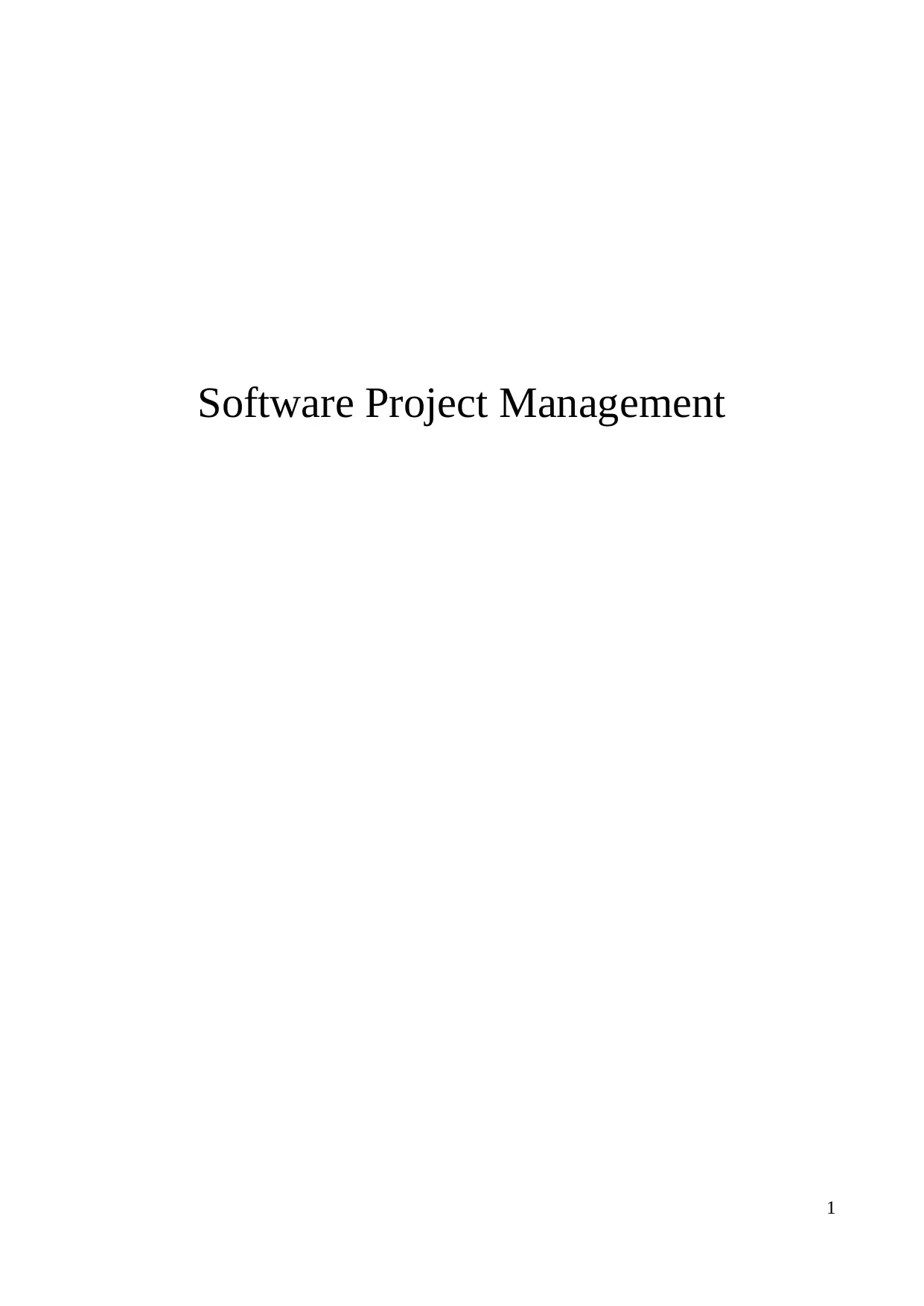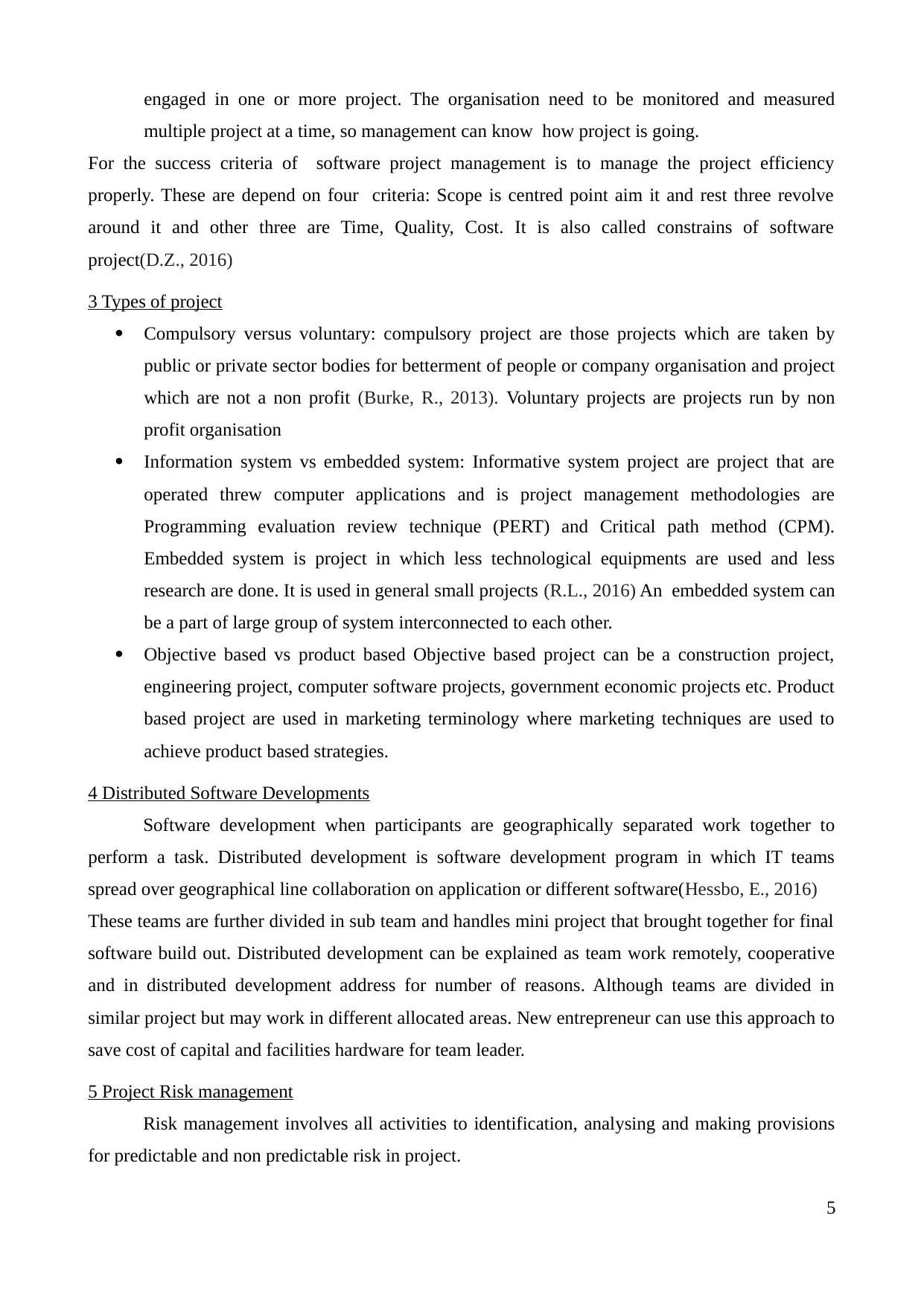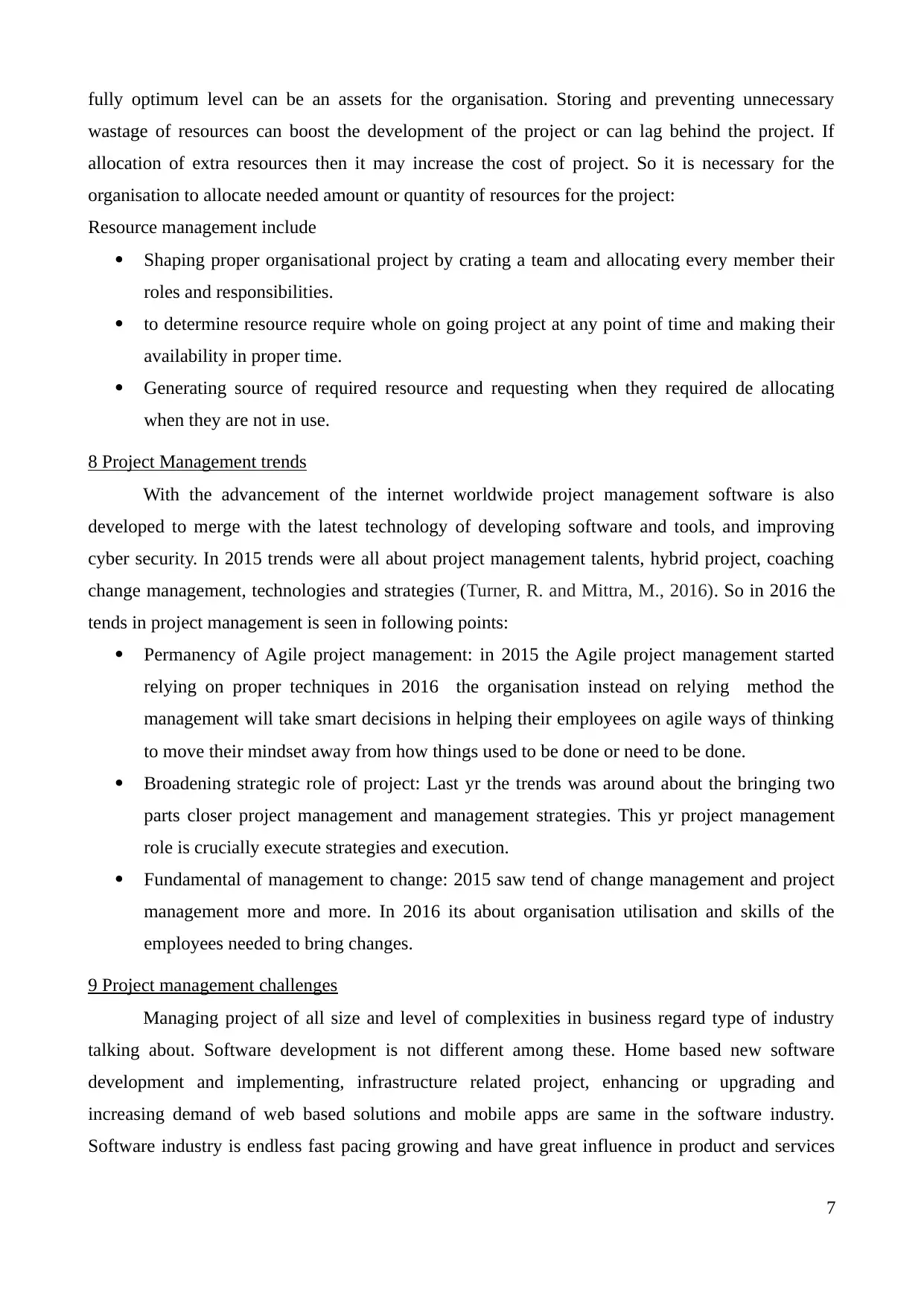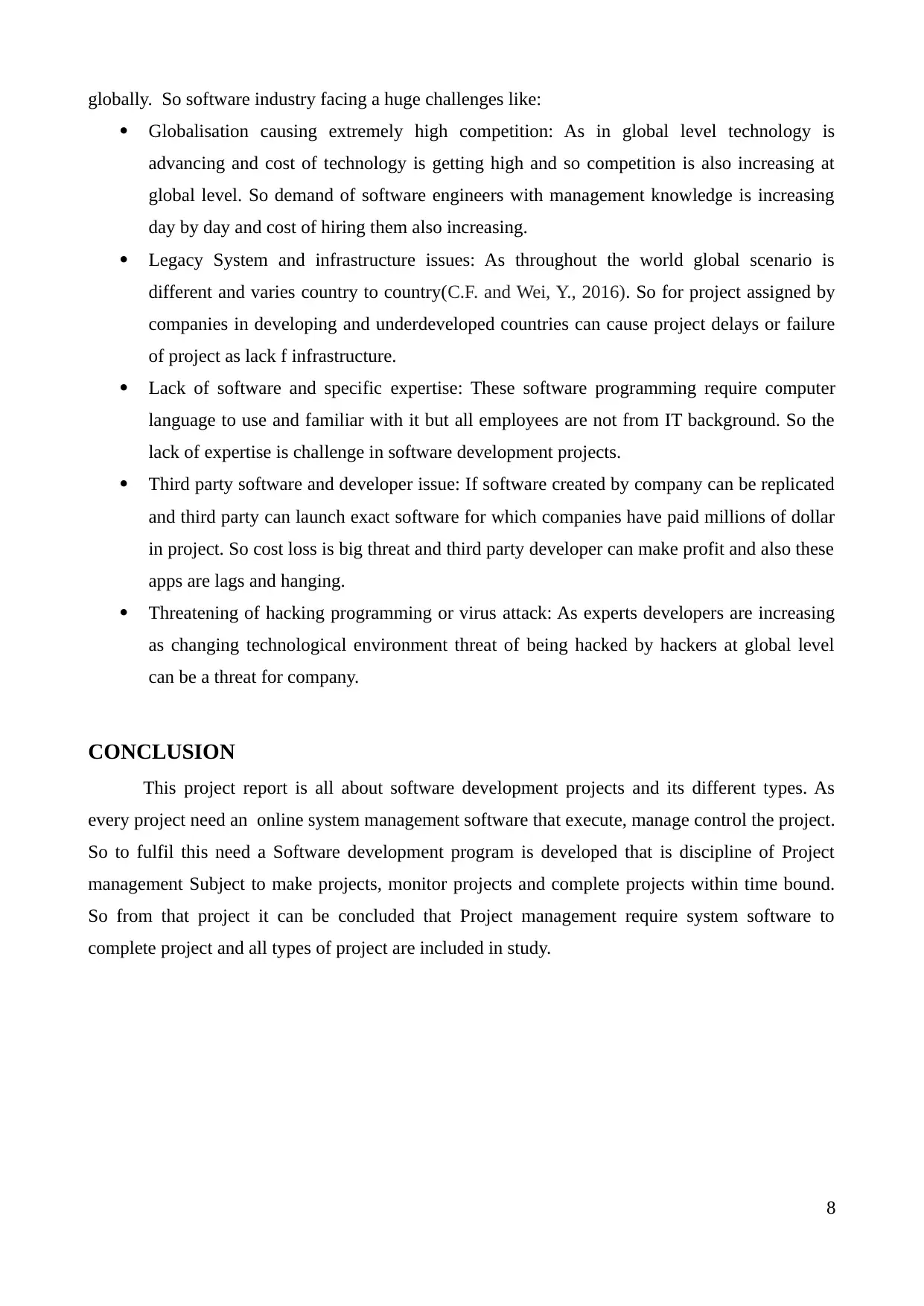Software Project Management: Trends, Risks, and Opportunities
VerifiedAdded on 2020/02/03
|9
|2347
|102
Report
AI Summary
This report provides a comprehensive overview of Software Project Management (SPM). It begins with an introduction to SPM, defining its scope and significance in planning and leading software projects. The report then delves into the core aspects of SPM, including the scope of software project management, characteristics and success criteria of SPM, and different types of projects (compulsory vs. voluntary, information system vs. embedded system, and objective-based vs. product-based). It further explores distributed software development, project risk management (scope, schedule, and resource risks), and the opportunities that arise within SPM. Resource allocation, project management trends (including Agile methodologies, strategic roles, and change management), and the challenges faced by the software industry (global competition, legacy systems, lack of expertise, third-party issues, and security threats) are also discussed. The report concludes by summarizing the key takeaways and emphasizing the importance of SPM in the software development lifecycle.

Software Project Management
1
1
Paraphrase This Document
Need a fresh take? Get an instant paraphrase of this document with our AI Paraphraser

Table of Contents
INTRODUCTION................................................................................................................................4
TASK....................................................................................................................................................4
1 Scope of Software Project Management.......................................................................................4
3 Types of project.............................................................................................................................5
4 Distributed Software Developments.............................................................................................5
5 Project Risk management.............................................................................................................5
6 opportunities.................................................................................................................................6
7 Resource allocation in Software project management..................................................................6
8 Project Management trends..........................................................................................................7
9 Project management challenges....................................................................................................7
Conclusion............................................................................................................................................8
References............................................................................................................................................9
2
INTRODUCTION................................................................................................................................4
TASK....................................................................................................................................................4
1 Scope of Software Project Management.......................................................................................4
3 Types of project.............................................................................................................................5
4 Distributed Software Developments.............................................................................................5
5 Project Risk management.............................................................................................................5
6 opportunities.................................................................................................................................6
7 Resource allocation in Software project management..................................................................6
8 Project Management trends..........................................................................................................7
9 Project management challenges....................................................................................................7
Conclusion............................................................................................................................................8
References............................................................................................................................................9
2

3
⊘ This is a preview!⊘
Do you want full access?
Subscribe today to unlock all pages.

Trusted by 1+ million students worldwide

INTRODUCTION
Software Project management is all about preparing projects in team and is an art and
science of planning and leading software projects. It is sub subject of project management in which
software are planned, monitored, directed, operated and controlled and executed. A project is
temporary group designed to develop unique product or services. A project is temporary because it
has particular time period to finish it. In this project the Software management project scope, and
types of projects are described. Furthermore project co ordination, communication, Software cost
and development team, Risk management, Resource allocation and software quality assurance are
explained.
TASK
1 Scope of Software Project Management
Software Project is complete procedure of development of software required collecting of
informations related to project, developing a software tool, testing and maintenance and carry out
procedure according to research methodologies adopted by business research operations within a
specified period of time to achieve project product (Burke, R., 2013). The scope of software project
management is so wide as it is developed by Information Industry(IT), and used in business,
scientific, educational, medical, and in government defence sector as well.
2 Characteristics and Success criteria of SPM
To choose a best project management software there are many things need to be considered.
All project can not utilise all features provided by Software, so in order to fully utilise project a
good understanding is needed (Royce, W., 1999). These are
Collaboration: Project management facilitate team collaboration. It means the concern
people related to project can access and use the project related information at any time.
Therefore project management software need to have full control on access and
authentication to grand assess to concern people
Scheduling: It is main feature of software project management that need to be provided by
software(Rai, A., 2004). Proper scheduling defines at what point of time and in with
available resources it can be utilised in specific deadline period.
Tracking Issues: During life cycle of project there can be many issues that need continuous
tracking and monitoring. Therefore it should have feature of keeping tracking of issues and
monitoring it.
Project Portfolio Management: It is one of the important aspect when an organisation is
4
Software Project management is all about preparing projects in team and is an art and
science of planning and leading software projects. It is sub subject of project management in which
software are planned, monitored, directed, operated and controlled and executed. A project is
temporary group designed to develop unique product or services. A project is temporary because it
has particular time period to finish it. In this project the Software management project scope, and
types of projects are described. Furthermore project co ordination, communication, Software cost
and development team, Risk management, Resource allocation and software quality assurance are
explained.
TASK
1 Scope of Software Project Management
Software Project is complete procedure of development of software required collecting of
informations related to project, developing a software tool, testing and maintenance and carry out
procedure according to research methodologies adopted by business research operations within a
specified period of time to achieve project product (Burke, R., 2013). The scope of software project
management is so wide as it is developed by Information Industry(IT), and used in business,
scientific, educational, medical, and in government defence sector as well.
2 Characteristics and Success criteria of SPM
To choose a best project management software there are many things need to be considered.
All project can not utilise all features provided by Software, so in order to fully utilise project a
good understanding is needed (Royce, W., 1999). These are
Collaboration: Project management facilitate team collaboration. It means the concern
people related to project can access and use the project related information at any time.
Therefore project management software need to have full control on access and
authentication to grand assess to concern people
Scheduling: It is main feature of software project management that need to be provided by
software(Rai, A., 2004). Proper scheduling defines at what point of time and in with
available resources it can be utilised in specific deadline period.
Tracking Issues: During life cycle of project there can be many issues that need continuous
tracking and monitoring. Therefore it should have feature of keeping tracking of issues and
monitoring it.
Project Portfolio Management: It is one of the important aspect when an organisation is
4
Paraphrase This Document
Need a fresh take? Get an instant paraphrase of this document with our AI Paraphraser

engaged in one or more project. The organisation need to be monitored and measured
multiple project at a time, so management can know how project is going.
For the success criteria of software project management is to manage the project efficiency
properly. These are depend on four criteria: Scope is centred point aim it and rest three revolve
around it and other three are Time, Quality, Cost. It is also called constrains of software
project(D.Z., 2016)
3 Types of project
Compulsory versus voluntary: compulsory project are those projects which are taken by
public or private sector bodies for betterment of people or company organisation and project
which are not a non profit (Burke, R., 2013). Voluntary projects are projects run by non
profit organisation
Information system vs embedded system: Informative system project are project that are
operated threw computer applications and is project management methodologies are
Programming evaluation review technique (PERT) and Critical path method (CPM).
Embedded system is project in which less technological equipments are used and less
research are done. It is used in general small projects (R.L., 2016) An embedded system can
be a part of large group of system interconnected to each other.
Objective based vs product based Objective based project can be a construction project,
engineering project, computer software projects, government economic projects etc. Product
based project are used in marketing terminology where marketing techniques are used to
achieve product based strategies.
4 Distributed Software Developments
Software development when participants are geographically separated work together to
perform a task. Distributed development is software development program in which IT teams
spread over geographical line collaboration on application or different software(Hessbo, E., 2016)
These teams are further divided in sub team and handles mini project that brought together for final
software build out. Distributed development can be explained as team work remotely, cooperative
and in distributed development address for number of reasons. Although teams are divided in
similar project but may work in different allocated areas. New entrepreneur can use this approach to
save cost of capital and facilities hardware for team leader.
5 Project Risk management
Risk management involves all activities to identification, analysing and making provisions
for predictable and non predictable risk in project.
5
multiple project at a time, so management can know how project is going.
For the success criteria of software project management is to manage the project efficiency
properly. These are depend on four criteria: Scope is centred point aim it and rest three revolve
around it and other three are Time, Quality, Cost. It is also called constrains of software
project(D.Z., 2016)
3 Types of project
Compulsory versus voluntary: compulsory project are those projects which are taken by
public or private sector bodies for betterment of people or company organisation and project
which are not a non profit (Burke, R., 2013). Voluntary projects are projects run by non
profit organisation
Information system vs embedded system: Informative system project are project that are
operated threw computer applications and is project management methodologies are
Programming evaluation review technique (PERT) and Critical path method (CPM).
Embedded system is project in which less technological equipments are used and less
research are done. It is used in general small projects (R.L., 2016) An embedded system can
be a part of large group of system interconnected to each other.
Objective based vs product based Objective based project can be a construction project,
engineering project, computer software projects, government economic projects etc. Product
based project are used in marketing terminology where marketing techniques are used to
achieve product based strategies.
4 Distributed Software Developments
Software development when participants are geographically separated work together to
perform a task. Distributed development is software development program in which IT teams
spread over geographical line collaboration on application or different software(Hessbo, E., 2016)
These teams are further divided in sub team and handles mini project that brought together for final
software build out. Distributed development can be explained as team work remotely, cooperative
and in distributed development address for number of reasons. Although teams are divided in
similar project but may work in different allocated areas. New entrepreneur can use this approach to
save cost of capital and facilities hardware for team leader.
5 Project Risk management
Risk management involves all activities to identification, analysing and making provisions
for predictable and non predictable risk in project.
5

Risk may include the following:
Leaving of experienced staff and joining of new staff.
Change in Management organisation.
Misinterpretation or miss communication of data.
Underestimating lime limit or resources.
Change in business operation, environment, Technology.
All projects starts with full throttle but there is some risk involved in failure of project.
Software development is an activity that uses variety of technology and require high level
knowledge because of these and other factor software management project has element of
uncertainty(Klakegg, O.J., 2016). So risk involved and different king of risk in project management
are scope risk, schedule risk and resource risk.
Scope Risk: Defining the need is not an easy task but to ensure about the need scope risk is
minimise the deliverables, objective and project character.
Schedule risk keep the timeline and define the critical path which is most difficult situation
that manager faces. Rely on parties whose output is out of the scope of the project, error
estimation, which are too optimistic, delay in decision making cos of equipment failure all
tends to delay the project.
Resources Risk: Main source of any project base is people or labor power and fund. If labor
force are unskilled or unable to perform task then or the project is understaffed from the
beginning so there is always resource risk in management and utilisation of resources.
6 opportunities
A project is temporary aspiration undertaken to create unique product, services or result. The
project is finished when project objective is achieved or project is terminated if project objective is
not achieved or loss been made in project. Scope or opportunities management is part of project
management which define the scope of project, which includes all activities and process need to be
done in order to make software product of deliverable. Opportunities management is essential
because it consider and converts all possible opportunities into the project objectives and is included
in project planning. Opportunity management is filtering and giving priority to factors involved in
project management.
7 Resource allocation in Software project management
All elements used to develop the software product may be considered as a resource for that
project. This include human resource, productive tools or equipments used in machinery and
software library. As everybody knows resources are available in limited quantities and if used at
6
Leaving of experienced staff and joining of new staff.
Change in Management organisation.
Misinterpretation or miss communication of data.
Underestimating lime limit or resources.
Change in business operation, environment, Technology.
All projects starts with full throttle but there is some risk involved in failure of project.
Software development is an activity that uses variety of technology and require high level
knowledge because of these and other factor software management project has element of
uncertainty(Klakegg, O.J., 2016). So risk involved and different king of risk in project management
are scope risk, schedule risk and resource risk.
Scope Risk: Defining the need is not an easy task but to ensure about the need scope risk is
minimise the deliverables, objective and project character.
Schedule risk keep the timeline and define the critical path which is most difficult situation
that manager faces. Rely on parties whose output is out of the scope of the project, error
estimation, which are too optimistic, delay in decision making cos of equipment failure all
tends to delay the project.
Resources Risk: Main source of any project base is people or labor power and fund. If labor
force are unskilled or unable to perform task then or the project is understaffed from the
beginning so there is always resource risk in management and utilisation of resources.
6 opportunities
A project is temporary aspiration undertaken to create unique product, services or result. The
project is finished when project objective is achieved or project is terminated if project objective is
not achieved or loss been made in project. Scope or opportunities management is part of project
management which define the scope of project, which includes all activities and process need to be
done in order to make software product of deliverable. Opportunities management is essential
because it consider and converts all possible opportunities into the project objectives and is included
in project planning. Opportunity management is filtering and giving priority to factors involved in
project management.
7 Resource allocation in Software project management
All elements used to develop the software product may be considered as a resource for that
project. This include human resource, productive tools or equipments used in machinery and
software library. As everybody knows resources are available in limited quantities and if used at
6
⊘ This is a preview!⊘
Do you want full access?
Subscribe today to unlock all pages.

Trusted by 1+ million students worldwide

fully optimum level can be an assets for the organisation. Storing and preventing unnecessary
wastage of resources can boost the development of the project or can lag behind the project. If
allocation of extra resources then it may increase the cost of project. So it is necessary for the
organisation to allocate needed amount or quantity of resources for the project:
Resource management include
Shaping proper organisational project by crating a team and allocating every member their
roles and responsibilities.
to determine resource require whole on going project at any point of time and making their
availability in proper time.
Generating source of required resource and requesting when they required de allocating
when they are not in use.
8 Project Management trends
With the advancement of the internet worldwide project management software is also
developed to merge with the latest technology of developing software and tools, and improving
cyber security. In 2015 trends were all about project management talents, hybrid project, coaching
change management, technologies and strategies (Turner, R. and Mittra, M., 2016). So in 2016 the
tends in project management is seen in following points:
Permanency of Agile project management: in 2015 the Agile project management started
relying on proper techniques in 2016 the organisation instead on relying method the
management will take smart decisions in helping their employees on agile ways of thinking
to move their mindset away from how things used to be done or need to be done.
Broadening strategic role of project: Last yr the trends was around about the bringing two
parts closer project management and management strategies. This yr project management
role is crucially execute strategies and execution.
Fundamental of management to change: 2015 saw tend of change management and project
management more and more. In 2016 its about organisation utilisation and skills of the
employees needed to bring changes.
9 Project management challenges
Managing project of all size and level of complexities in business regard type of industry
talking about. Software development is not different among these. Home based new software
development and implementing, infrastructure related project, enhancing or upgrading and
increasing demand of web based solutions and mobile apps are same in the software industry.
Software industry is endless fast pacing growing and have great influence in product and services
7
wastage of resources can boost the development of the project or can lag behind the project. If
allocation of extra resources then it may increase the cost of project. So it is necessary for the
organisation to allocate needed amount or quantity of resources for the project:
Resource management include
Shaping proper organisational project by crating a team and allocating every member their
roles and responsibilities.
to determine resource require whole on going project at any point of time and making their
availability in proper time.
Generating source of required resource and requesting when they required de allocating
when they are not in use.
8 Project Management trends
With the advancement of the internet worldwide project management software is also
developed to merge with the latest technology of developing software and tools, and improving
cyber security. In 2015 trends were all about project management talents, hybrid project, coaching
change management, technologies and strategies (Turner, R. and Mittra, M., 2016). So in 2016 the
tends in project management is seen in following points:
Permanency of Agile project management: in 2015 the Agile project management started
relying on proper techniques in 2016 the organisation instead on relying method the
management will take smart decisions in helping their employees on agile ways of thinking
to move their mindset away from how things used to be done or need to be done.
Broadening strategic role of project: Last yr the trends was around about the bringing two
parts closer project management and management strategies. This yr project management
role is crucially execute strategies and execution.
Fundamental of management to change: 2015 saw tend of change management and project
management more and more. In 2016 its about organisation utilisation and skills of the
employees needed to bring changes.
9 Project management challenges
Managing project of all size and level of complexities in business regard type of industry
talking about. Software development is not different among these. Home based new software
development and implementing, infrastructure related project, enhancing or upgrading and
increasing demand of web based solutions and mobile apps are same in the software industry.
Software industry is endless fast pacing growing and have great influence in product and services
7
Paraphrase This Document
Need a fresh take? Get an instant paraphrase of this document with our AI Paraphraser

globally. So software industry facing a huge challenges like:
Globalisation causing extremely high competition: As in global level technology is
advancing and cost of technology is getting high and so competition is also increasing at
global level. So demand of software engineers with management knowledge is increasing
day by day and cost of hiring them also increasing.
Legacy System and infrastructure issues: As throughout the world global scenario is
different and varies country to country(C.F. and Wei, Y., 2016). So for project assigned by
companies in developing and underdeveloped countries can cause project delays or failure
of project as lack f infrastructure.
Lack of software and specific expertise: These software programming require computer
language to use and familiar with it but all employees are not from IT background. So the
lack of expertise is challenge in software development projects.
Third party software and developer issue: If software created by company can be replicated
and third party can launch exact software for which companies have paid millions of dollar
in project. So cost loss is big threat and third party developer can make profit and also these
apps are lags and hanging.
Threatening of hacking programming or virus attack: As experts developers are increasing
as changing technological environment threat of being hacked by hackers at global level
can be a threat for company.
CONCLUSION
This project report is all about software development projects and its different types. As
every project need an online system management software that execute, manage control the project.
So to fulfil this need a Software development program is developed that is discipline of Project
management Subject to make projects, monitor projects and complete projects within time bound.
So from that project it can be concluded that Project management require system software to
complete project and all types of project are included in study.
8
Globalisation causing extremely high competition: As in global level technology is
advancing and cost of technology is getting high and so competition is also increasing at
global level. So demand of software engineers with management knowledge is increasing
day by day and cost of hiring them also increasing.
Legacy System and infrastructure issues: As throughout the world global scenario is
different and varies country to country(C.F. and Wei, Y., 2016). So for project assigned by
companies in developing and underdeveloped countries can cause project delays or failure
of project as lack f infrastructure.
Lack of software and specific expertise: These software programming require computer
language to use and familiar with it but all employees are not from IT background. So the
lack of expertise is challenge in software development projects.
Third party software and developer issue: If software created by company can be replicated
and third party can launch exact software for which companies have paid millions of dollar
in project. So cost loss is big threat and third party developer can make profit and also these
apps are lags and hanging.
Threatening of hacking programming or virus attack: As experts developers are increasing
as changing technological environment threat of being hacked by hackers at global level
can be a threat for company.
CONCLUSION
This project report is all about software development projects and its different types. As
every project need an online system management software that execute, manage control the project.
So to fulfil this need a Software development program is developed that is discipline of Project
management Subject to make projects, monitor projects and complete projects within time bound.
So from that project it can be concluded that Project management require system software to
complete project and all types of project are included in study.
8

REFERENCES
Books and Journals
Burke, R., 2013. Project management: planning and control techniques. New Jersey, USA.
Royce, W., 1999. Software project management. Pearson Education India.
Burke, R., 2013. Project management: planning and control techniques. New Jersey, USA.
Wallace, L., Keil, M. and Rai, A., 2004. Understanding software project risk: a cluster analysis.
Information & Management, 42(1), pp.115-125.
Martinelli, R.J. and Milosevic, D.Z., 2016. Project management toolbox: tools and techniques for
the practicing project manager. John Wiley & Sons.
Boctor, F.F. and Kadri, R.L., 2016. The Generalized Resource Allocation and Leveling Problem in
Project Scheduling.
Klakegg, O.J., 2016. Project Risk Management: Challenge Established Practice.
Wang, T., Tang, W., Du, L., Duffield, C.F. and Wei, Y., 2016. Relationships among Risk
Management, Partnering, and Contractor Capability in International EPC Project
Delivery. Journal of Management in Engineering, 32(6), p.04016017.
Jabangwe, R., Šmite, D. and Hessbo, E., 2016. Distributed software development in an offshore
outsourcing project: A case study of source code evolution and quality. Information and
Software Technology, 72, pp.125-136.
Alvarez-Dionisi, L.E., Turner, R. and Mittra, M., 2016. Global project management trends.
International Journal of Information Technology Project Management (IJITPM), 7(3),
pp.54-73.
9
Books and Journals
Burke, R., 2013. Project management: planning and control techniques. New Jersey, USA.
Royce, W., 1999. Software project management. Pearson Education India.
Burke, R., 2013. Project management: planning and control techniques. New Jersey, USA.
Wallace, L., Keil, M. and Rai, A., 2004. Understanding software project risk: a cluster analysis.
Information & Management, 42(1), pp.115-125.
Martinelli, R.J. and Milosevic, D.Z., 2016. Project management toolbox: tools and techniques for
the practicing project manager. John Wiley & Sons.
Boctor, F.F. and Kadri, R.L., 2016. The Generalized Resource Allocation and Leveling Problem in
Project Scheduling.
Klakegg, O.J., 2016. Project Risk Management: Challenge Established Practice.
Wang, T., Tang, W., Du, L., Duffield, C.F. and Wei, Y., 2016. Relationships among Risk
Management, Partnering, and Contractor Capability in International EPC Project
Delivery. Journal of Management in Engineering, 32(6), p.04016017.
Jabangwe, R., Šmite, D. and Hessbo, E., 2016. Distributed software development in an offshore
outsourcing project: A case study of source code evolution and quality. Information and
Software Technology, 72, pp.125-136.
Alvarez-Dionisi, L.E., Turner, R. and Mittra, M., 2016. Global project management trends.
International Journal of Information Technology Project Management (IJITPM), 7(3),
pp.54-73.
9
⊘ This is a preview!⊘
Do you want full access?
Subscribe today to unlock all pages.

Trusted by 1+ million students worldwide
1 out of 9
Related Documents
Your All-in-One AI-Powered Toolkit for Academic Success.
+13062052269
info@desklib.com
Available 24*7 on WhatsApp / Email
![[object Object]](/_next/static/media/star-bottom.7253800d.svg)
Unlock your academic potential
Copyright © 2020–2025 A2Z Services. All Rights Reserved. Developed and managed by ZUCOL.





